Introduction
Pretoria, often called the Jacaranda City, is one of South Africa’s most captivating destinations. While Johannesburg and Cape Town may attract more global attention, Pretoria offers an equally rewarding experience with its mix of history, culture, and natural charm. Every spring, the city transforms into a vibrant purple wonderland as thousands of jacaranda trees blossom. There are so many exciting things to do in Pretoria, from exploring historic landmarks to enjoying its colorful markets and gardens.
Travelers searching for the best things to do in Pretoria will quickly discover a city that combines stately government buildings with fascinating museums, lively markets, and tranquil green spaces. As the administrative capital of South Africa, Pretoria holds a unique place in the nation’s story, from colonial times to the modern democratic era.
This detailed Pretoria travel guide covers everything you need to know—from how to get there, where to stay, and how to get around, to safety tips and must-see attractions. By the end, you’ll see why Pretoria is more than just a political hub—it’s a destination that deserves a place on every traveler’s itinerary. From historic landmarks to modern attractions, the variety of things to do in Pretoria makes it one of South Africa’s most rewarding cities to explore.
Whether you’re drawn to history, culture, or nature, there are countless things to do in Pretoria that make it one of South Africa’s most rewarding cities.
Pretoria Travel Guide
Overview of Pretoria
Located in Gauteng Province, about 55 kilometers north of Johannesburg, Pretoria is renowned for its jacaranda-lined streets, elegant boulevards, and striking architecture. Historically, the city served as the capital of the Boer Republic before becoming South Africa’s administrative center. Today, it reflects both the legacy of the past and the vision of a modern nation.
Pretoria’s charm lies in its contrasts: tree-lined streets against sandstone government buildings, historic squares beside bustling shopping centers, and cultural landmarks surrounded by nature reserves. For visitors, this balance makes Pretoria a city that can be explored at a relaxed pace while still offering plenty of discovery.
Getting to Pretoria
Pretoria does not have an international airport. Most visitors arrive via O.R. Tambo International Airport in Johannesburg, one of Africa’s busiest gateways. From there, travelers have several convenient ways to reach the city:
-
By Car:
-
The drive takes 45–60 minutes along the N1 highway, offering flexibility and ease.
-
By Train:
-
The Gautrain, a modern high-speed rail service, connects Johannesburg, O.R. Tambo, and Pretoria in under an hour.
-
By Bus or Shuttle:
-
Budget-friendly buses and shuttles run frequently between Johannesburg and Pretoria.
For those already in South Africa, Pretoria is also accessible by road from cities such as Durban, Cape Town, and Polokwane, though flights into Johannesburg remain the most practical long-distance option.
Getting Around Pretoria
Moving around Pretoria is relatively straightforward:
-
Public Transport:
-
Buses and minibus taxis operate widely but can be confusing for first-time visitors.
-
Gautrain Stations:
-
Pretoria, Hatfield, and Centurion stations connect the city to Johannesburg and the surrounding areas.
-
Ride-Hailing Apps:
-
Uber and Bolt are reliable and safe.
-
Car Rentals:
-
Recommended for travelers planning day trips or exploring nearby reserves.
-
Walking and Cycling:
-
Neighborhoods like Hatfield are pedestrian-friendly, though the distance between major attractions often requires transport.
Where to Stay in Pretoria
Accommodation in Pretoria caters to all budgets and preferences:
-
Luxury Hotels:
-
Options like the Sheraton Pretoria Hotel and Menlyn Boutique Hotel offer comfort and excellent amenities.
-
Mid-Range Hotels:
-
Premier Hotel and City Lodge Hatfield provide good value in convenient locations.
-
Budget Choices:
-
Backpacker lodges and guesthouses are affordable and traveler-friendly.
-
Unique Stays:
-
Boutique guesthouses and safari-style lodges provide distinctive experiences.
Popular areas to stay include Hatfield, Arcadia, and Brooklyn, known for their proximity to attractions, restaurants, and shopping centers.
Safety and Travel Tips
Pretoria is generally welcoming, but like most urban centers, it requires a few safety precautions:
-
Avoid walking alone at night in quiet or unfamiliar areas.
-
Use trusted transport services such as Uber.
-
Keep valuables discreet and secure in busy public spaces.
-
Choose accommodations in safe, central neighborhoods.
English is widely spoken, though Afrikaans and indigenous languages such as Setswana and Sepedi are also common. The local currency is the South African Rand (ZAR), and credit cards are accepted in most hotels, restaurants, and shops.
By following these tips, visitors can explore Pretoria confidently while enjoying its unique blend of culture, history, and natural beauty.
Pretoria Tourist Attractions
Nature reserves, museums, and vibrant markets are just a few of the unforgettable things to do in Pretoria that every traveler should experience. Pretoria is South Africa’s administrative capital, but it is far more than just a center of politics. The city offers a wide variety of attractions, ranging from historic landmarks to lush gardens and engaging museums. For travelers searching for the best things to do in Pretoria, these sites are often at the top of the list.
Historical Landmarks
Pretoria’s history is deeply tied to the country’s political and cultural transformation, and its landmarks provide fascinating insight into this journey.
-
Church Square:
-
Located in the heart of the city, Church Square is surrounded by significant buildings such as the Palace of Justice, where Nelson Mandela and his fellow activists were tried during the Rivonia Trial. A bronze statue of Paul Kruger, a prominent Boer leader, stands at the center, reflecting the city’s historical legacy.
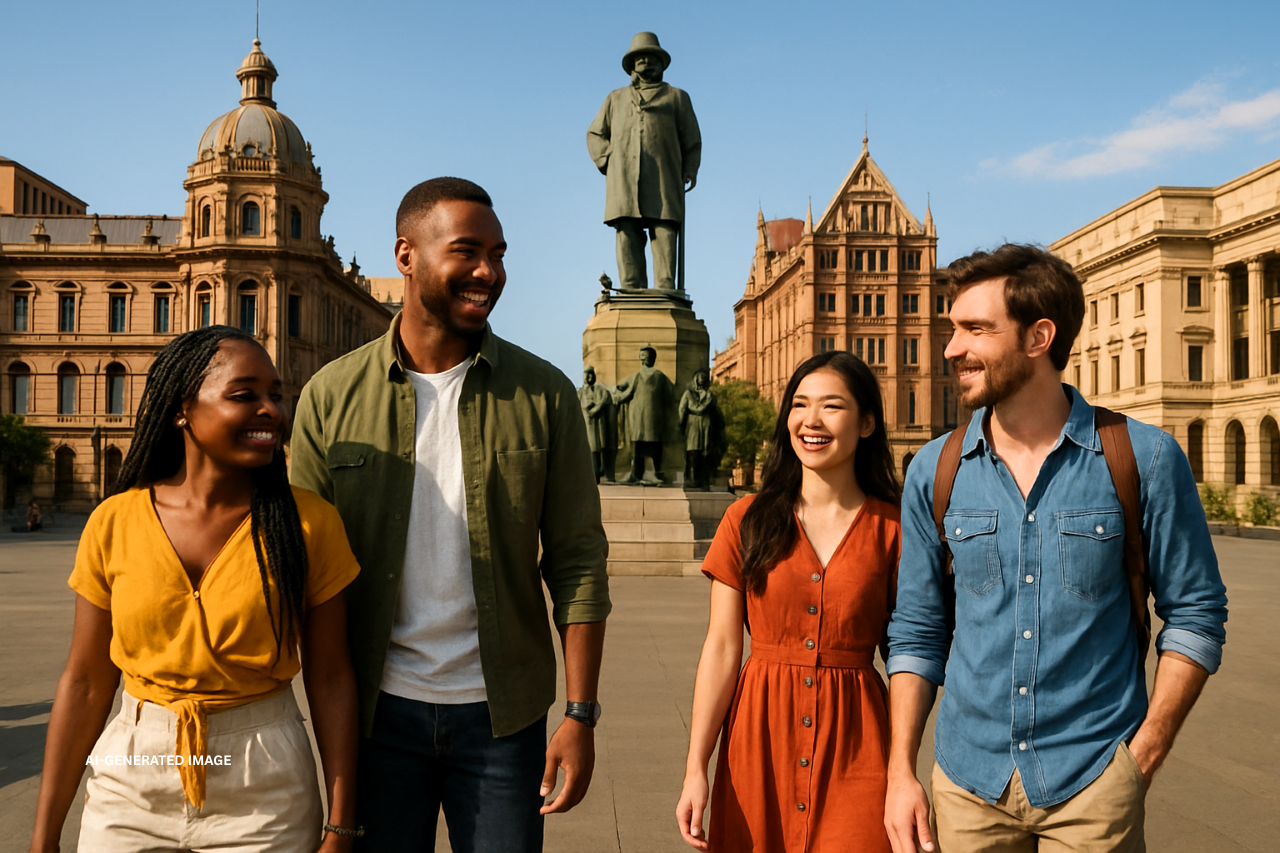
-
Melrose House:
-
This Victorian-era mansion became a pivotal site during the Anglo-Boer War, as it was where the Treaty of Vereeniging was signed in 1902, ending the conflict. Today, the house operates as a museum, complete with original furnishings and exhibits that transport visitors back in time.
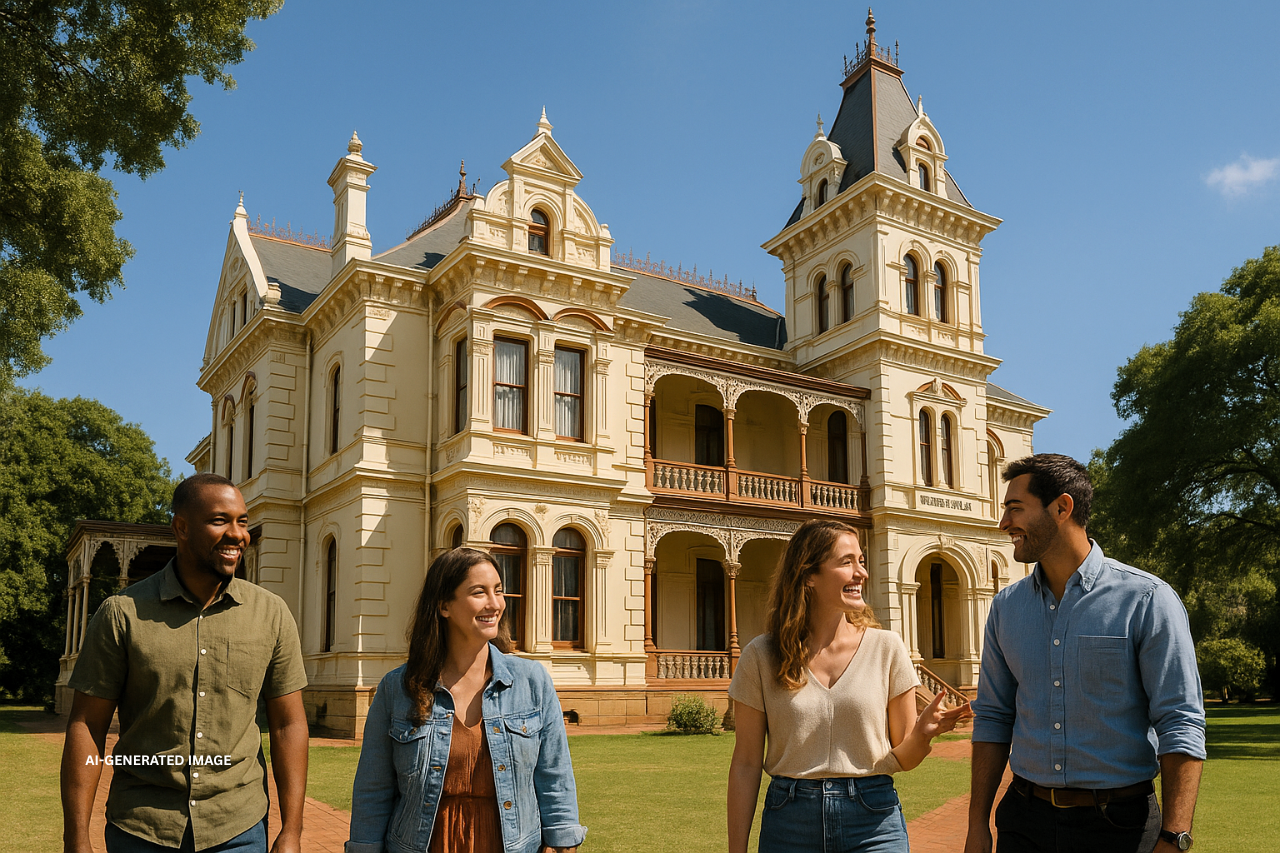
-
Freedom Park:
-
Positioned on Salvokop Hill, Freedom Park honors those who sacrificed their lives during South Africa’s struggle for democracy. Its memorials and gardens provide both a reflective atmosphere and panoramic views of the city.
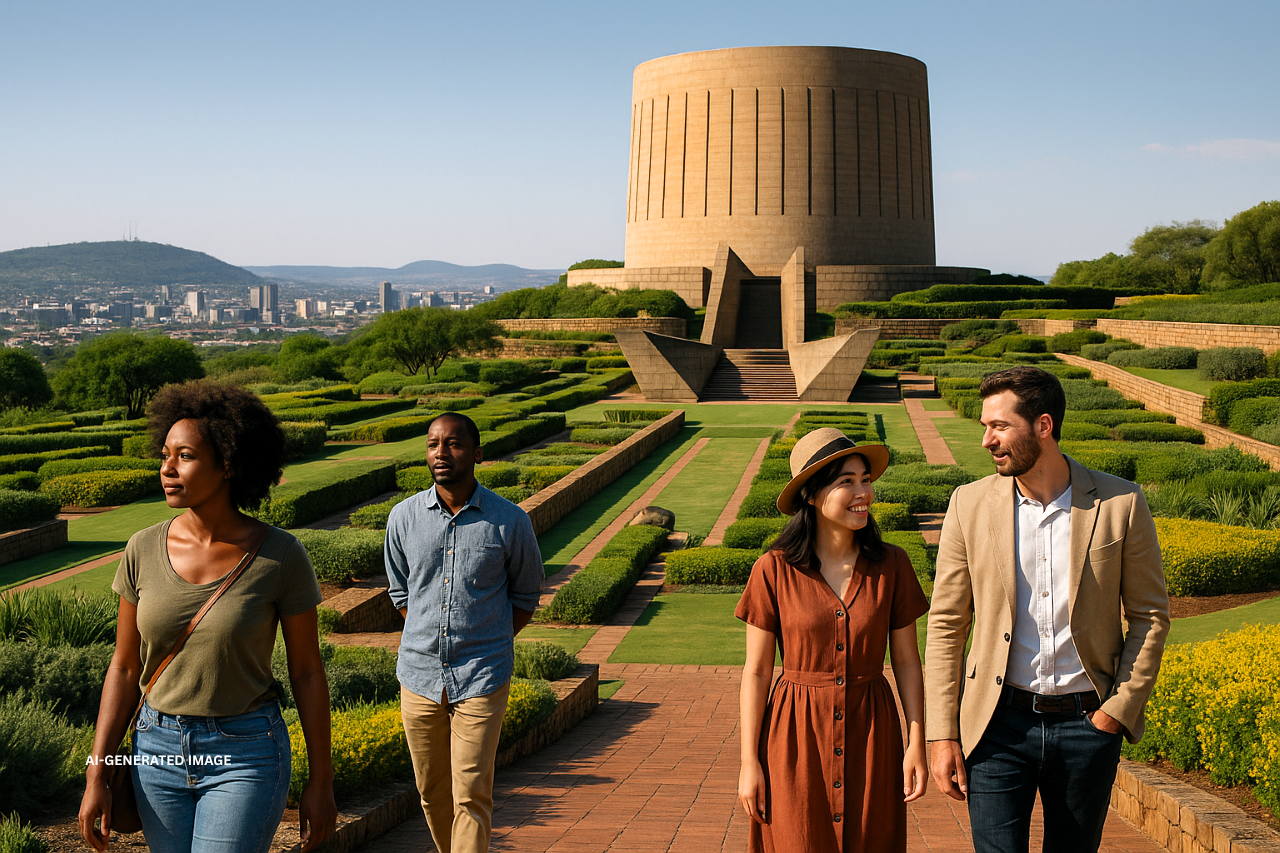
Museums and Cultural Spaces
Pretoria is home to a variety of museums and galleries that appeal to art lovers, history enthusiasts, and families alike.
-
National Cultural History Museum:
-
This museum explores South Africa’s diverse cultural heritage, highlighting indigenous traditions, colonial history, and artifacts from the apartheid era.
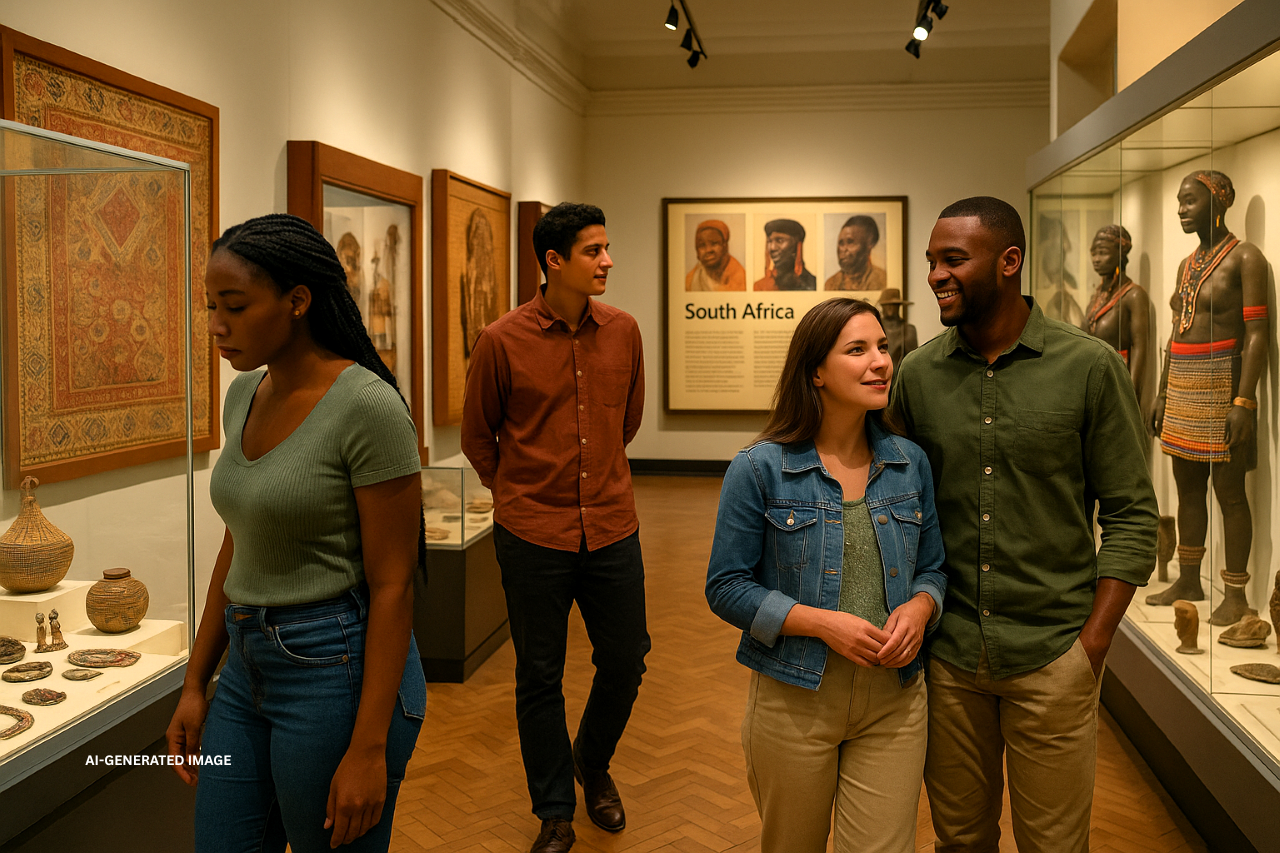
-
Pretoria Art Museum:
-
Featuring an extensive collection of South African art, the museum showcases works by both established and emerging artists, offering insight into the nation’s creative spirit.
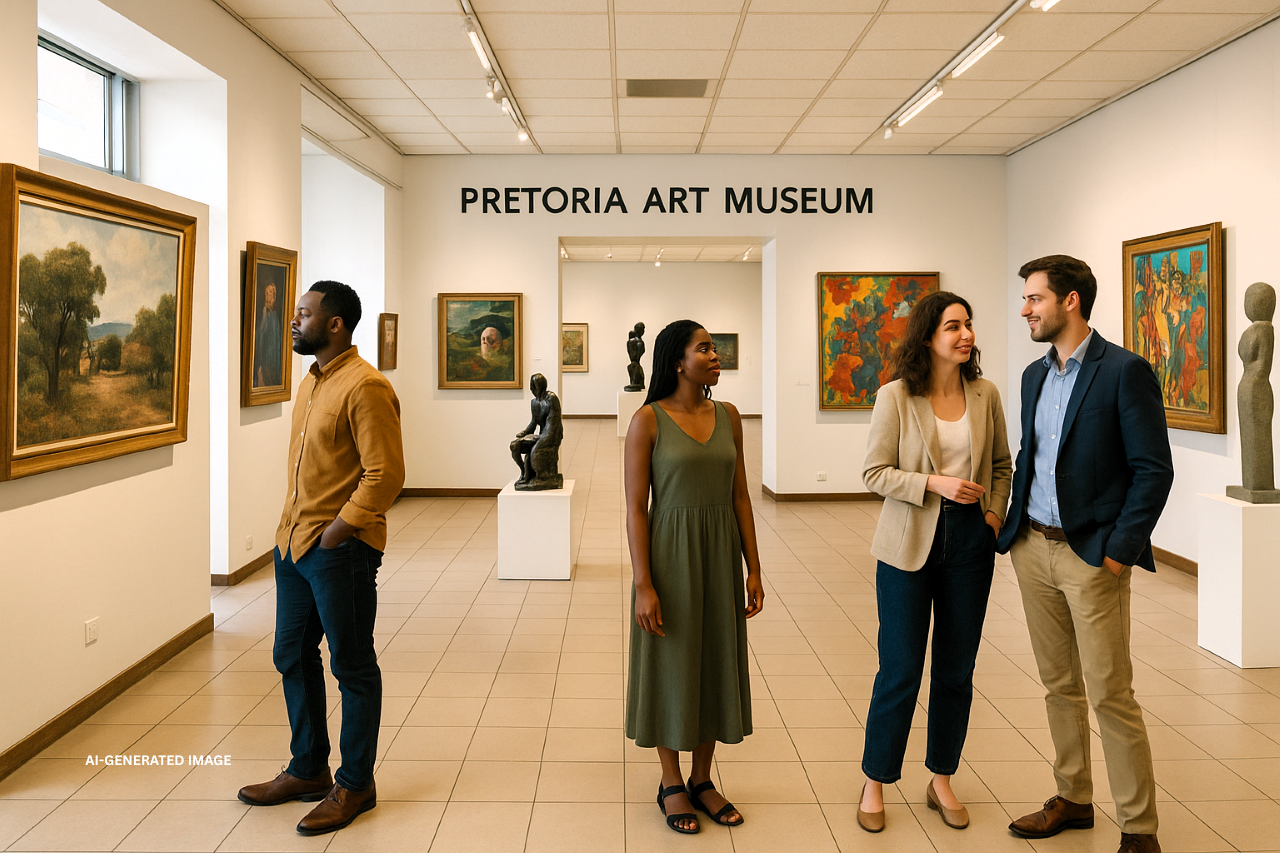
-
Ditsong National Museum of Natural History (Transvaal Museum):
-
Famous for its fossil collection, this museum allows visitors to explore South Africa’s prehistoric wildlife and early human history. It’s a family-friendly attraction and one of Pretoria’s educational highlights.
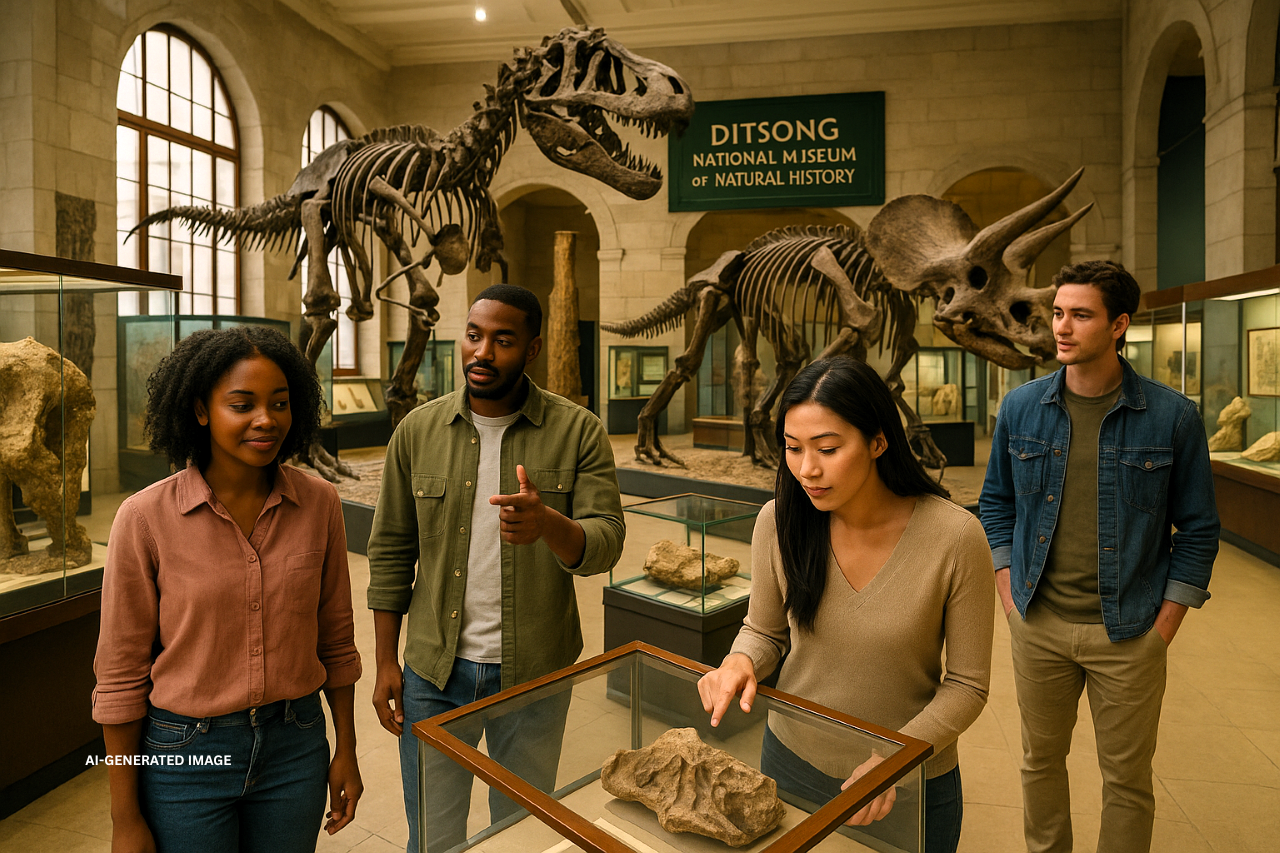
Nature and Outdoor Spaces
Unlike many capitals around the world, Pretoria is rich in green spaces, making it a refreshing city to explore.
-
National Zoological Gardens (Pretoria Zoo):
-
One of Africa’s largest zoos, home to over 700 species, including elephants, lions, and reptiles. It also features an aquarium and reptile park, making it especially popular with families.

-
Pretoria National Botanical Garden:
-
A peaceful oasis filled with indigenous plants, birdlife, and scenic walking paths. It’s perfect for a relaxing stroll, photography, or a picnic.
-
Groenkloof Nature Reserve:
-
Located close to the city center, this reserve offers hiking, cycling, and wildlife viewing opportunities. Visitors often spot giraffes, zebras, and antelope while exploring its trails.
Religious and Architectural Landmarks
Pretoria’s architecture reflects its layered history, with colonial, neoclassical, and modern influences visible throughout the city.
-
Dutch Reformed Church on Church Square:
-
An important religious and architectural landmark.
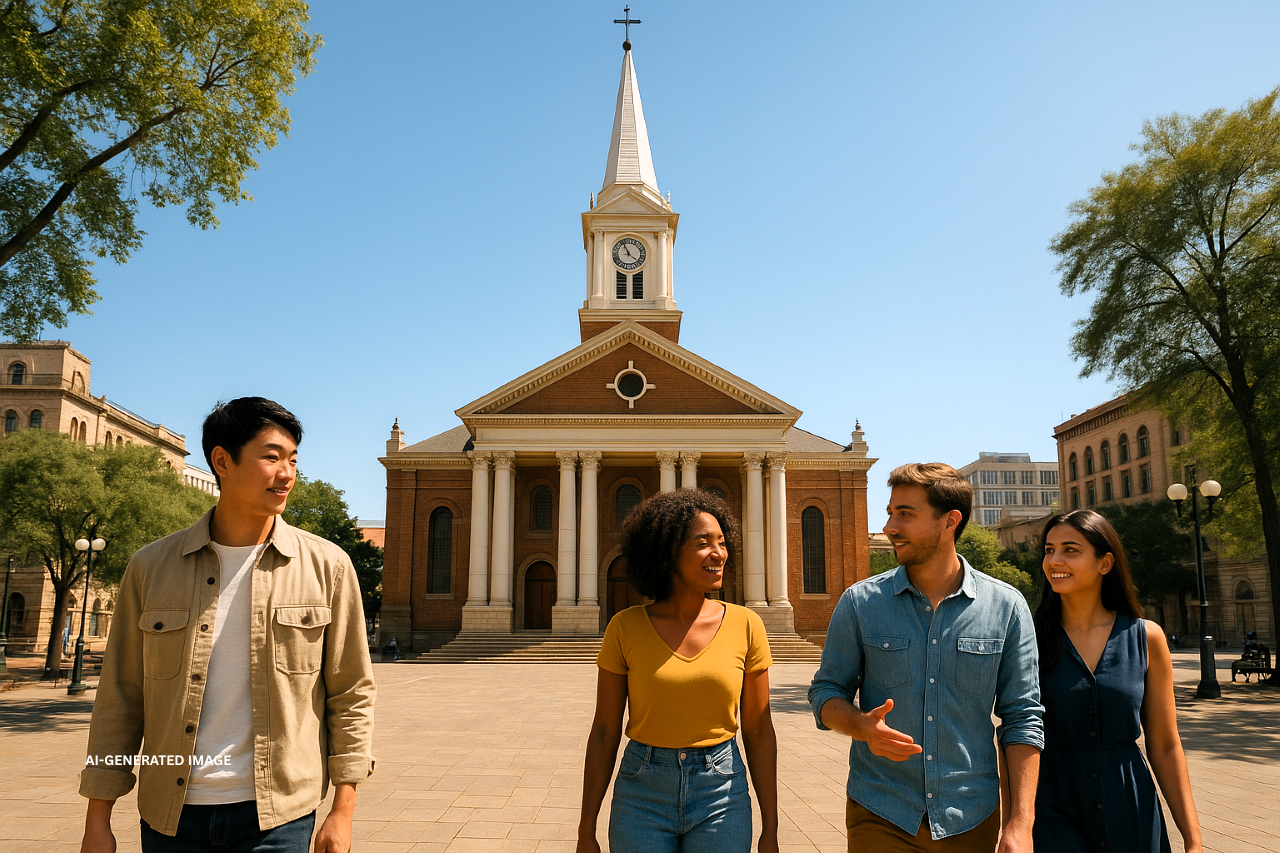
-
Melrose House:
-
Admired not only for its history but also for its Victorian-era design.
-
Union Buildings:
-
The most iconic symbol of Pretoria is highlighted in detail below.
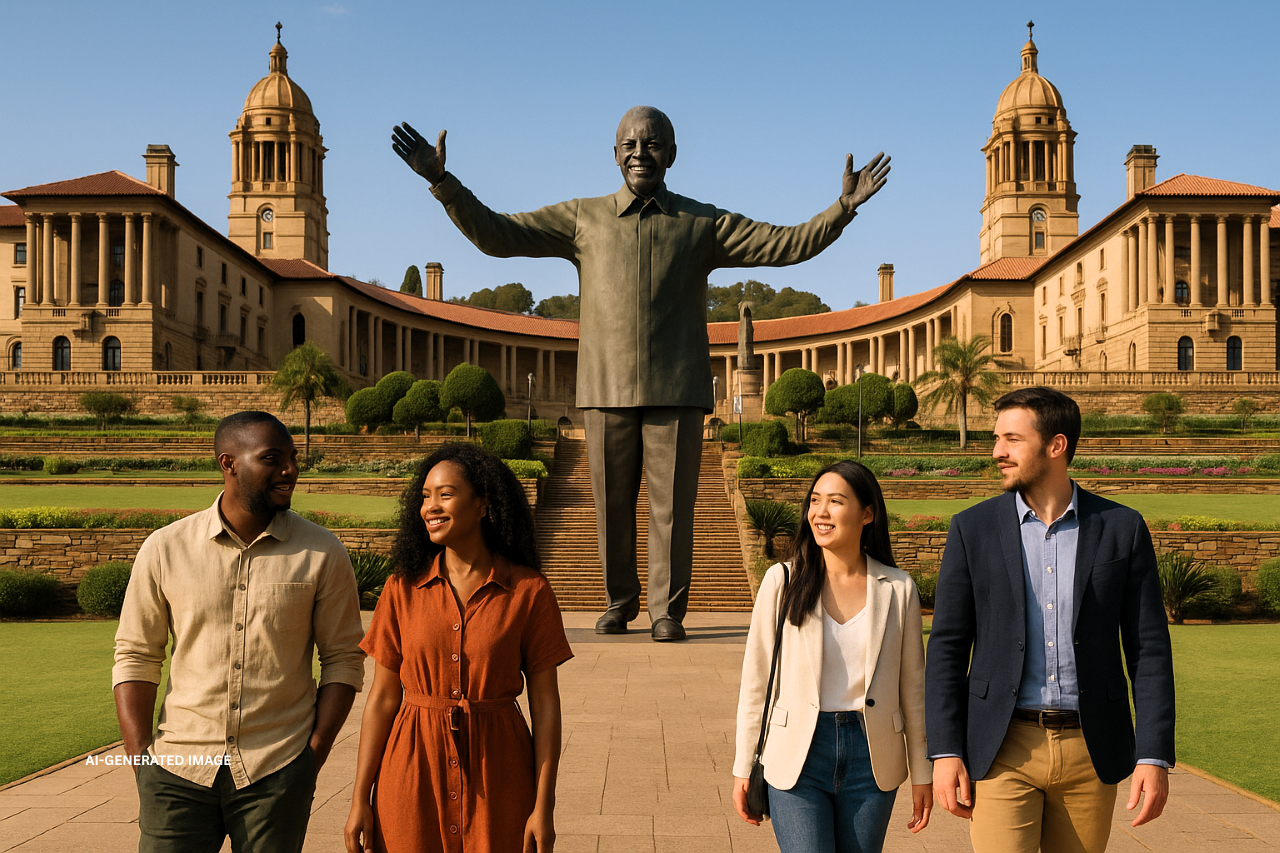
If you’re creating a travel itinerary, these attractions should top your list of things to do in Pretoria.
Union Buildings, Pretoria
Among all Pretoria tourist attractions, the Union Buildings remain the most iconic and historically significant. Visiting the Union Buildings, with its sweeping gardens and historic significance, is among the most iconic things to do in Pretoria.
History and Architecture
Designed by Sir Herbert Baker and completed in 1913, the Union Buildings symbolize the unification of South Africa’s provinces into one state. Constructed from light sandstone, the complex combines Neoclassical and Cape Dutch styles, with sweeping wings, domes, and elegant staircases. Its commanding position on Meintjieskop Hill makes it one of the most photographed sites in the city.
Role in Modern South Africa
The Union Buildings have played a central role in South Africa’s political evolution.
-
In 1994, Nelson Mandela was inaugurated here as the country’s first democratically elected president, marking the dawn of a new era.
-
The site has hosted national celebrations, protests, and memorials.
-
Today, it serves as the official seat of the South African government and houses the offices of the president.
For visitors, walking the grounds of the Union Buildings is not just a sightseeing activity but a chance to stand at the heart of South Africa’s democratic history.
Visitor Information
While access to the interior is restricted due to government use, the gardens and terraces surrounding the buildings are open to the public.
-
Gardens:
-
Landscaped with indigenous plants, sculptures, and memorials, including the famous nine-meter-tall Nelson Mandela statue with arms outstretched in welcome.
-
Views:
-
The elevated setting provides sweeping views of Pretoria, especially breathtaking during jacaranda season when the city turns purple.
-
Tips:
-
Entry to the gardens is free. Visiting early in the morning or late afternoon offers the best conditions for photography.
Why Visit the Union Buildings?
The Union Buildings in Pretoria are not just the administrative hub of the country—they are also a symbol of South Africa’s resilience, unity, and progress. For anyone compiling a list of things to do in Pretoria, this landmark deserves to be at the very top. Visiting the Union Buildings is one of the most meaningful things to do in Pretoria, as it connects travelers with South Africa’s political history.
Voortrekker Monument Pretoria
When exploring the best things to do in Pretoria, the Voortrekker Monument is one of the city’s most prominent attractions. Towering above the skyline, this granite landmark is both architecturally striking and historically significant.
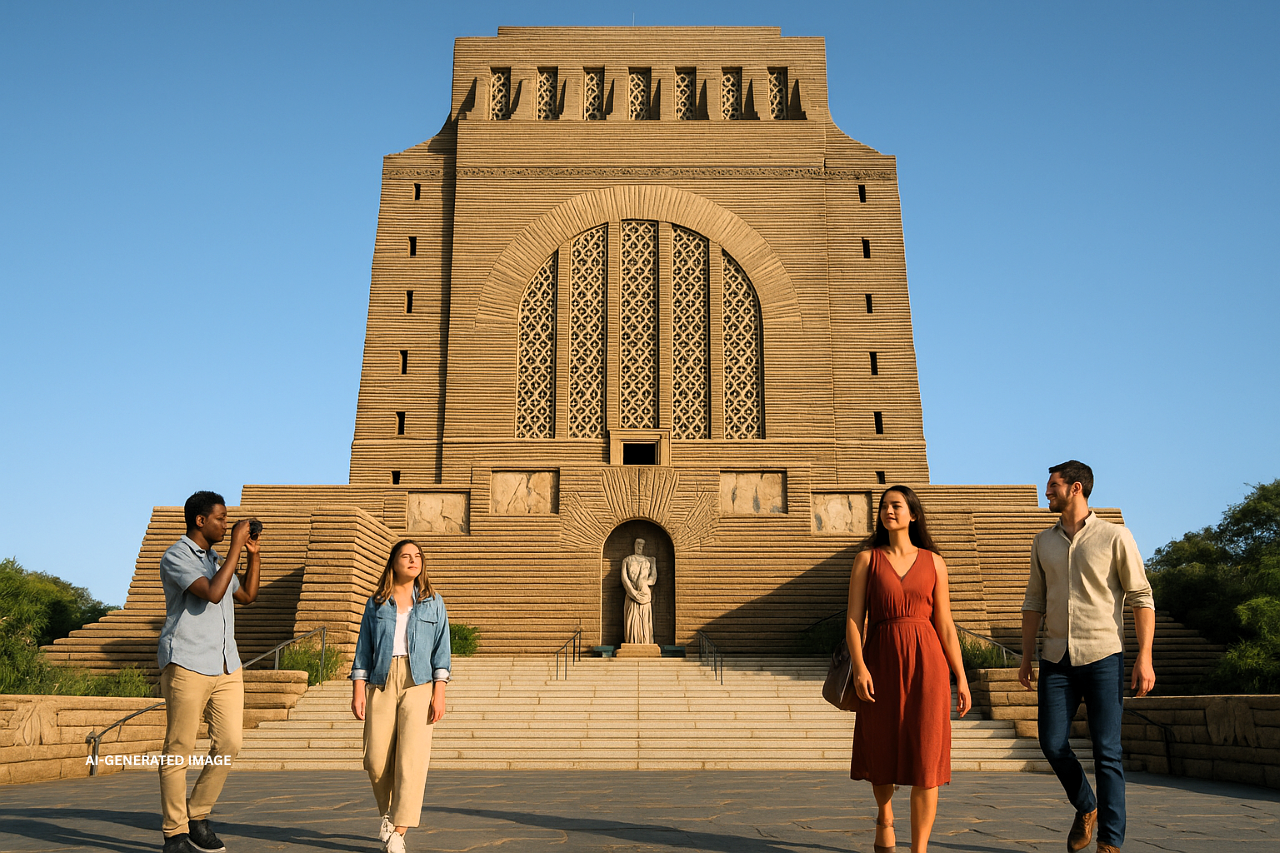
Historical Significance
The Voortrekker Monument was built to commemorate the Voortrekkers—Afrikaner pioneers who embarked on the Great Trek in the 1830s and 1840s in search of independence and new land beyond the Cape Colony.
Completed in 1949, the monument became a powerful symbol of Afrikaner identity during the apartheid era. Today, it is recognized as an important part of South Africa’s history, offering visitors the opportunity to reflect on the challenges and achievements of those who shaped the nation’s early frontier years.
Design and Features
The monument is as remarkable for its design as it is for its historical symbolism.
-
Structure:
-
Standing 40 meters high, the building dominates its surroundings and can be seen from across Pretoria.
-
Hall of Heroes:
-
Inside, the marble frieze—
-
The longest of its kind in the world depicts scenes from the Great Trek, portraying the hardships and determination of the pioneers.
-
Cenotaph:
-
At the monument’s center lies a symbolic grave. On December 16 each year, a shaft of sunlight passes through the roof to illuminate the cenotaph, symbolizing divine blessing.
-
Exhibits and Museum:
-
The surrounding museum offers detailed displays about Afrikaner heritage, the Great Trek, and interactions with indigenous communities.
Visiting the Monument
-
Opening Hours:
-
The monument is open daily from morning until late afternoon.
-
Entrance Fees:
-
Affordable, with discounts available for children, students, and groups.
-
Nature Reserve:
-
The site includes a reserve where visitors may spot wildlife such as antelopes and zebras.
-
Travel Tips:
-
Early morning visits are best for photography and smaller crowds. Guided tours are available for a deeper historical context.
The Voortrekker Monument in Pretoria is an essential stop for history lovers and travelers curious about South Africa’s cultural identity.
Cultural Experiences in Pretoria
While monuments highlight Pretoria’s past, its vibrant cultural life reveals the spirit of the present. The city’s festivals, food, shopping, and nightlife add energy and color to any visit.
Festivals and Events
Pretoria comes alive during annual celebrations and cultural events.
-
Jacaranda Festival:
-
Held when the jacaranda trees bloom in spring, this festival features parades, live music, and local markets.
-
Heritage Day (Braai Day):
-
Celebrated across South Africa in September, this day encourages communities to showcase cultural traditions, often centered around the beloved braai (barbecue).
-
Arts and Music Events:
-
Pretoria regularly hosts concerts, theater productions, and smaller cultural festivals that showcase local talent.
For travelers, aligning a trip with one of these events is a wonderful way to connect with locals.
Food and Dining
Pretoria’s dining scene is a reflection of its cultural diversity.
-
Traditional Dishes:
-
Braai (barbecue) is a South African staple and social tradition.
-
Bunny chow, a hollowed-out loaf filled with curry, is a local favorite.
-
Pap with chakalaka (maize porridge with spicy relish) is a common side dish.
-
-
Where to Eat:
-
Brooklyn and Menlyn are known for fine dining and international cuisine.
-
Hazel Food Market is perfect for artisanal foods, fresh produce, and gourmet street meals.
-
Hatfield offers trendy cafés and casual dining spots popular with students and young professionals.
-
Experiencing the city’s food culture is one of the tastiest things to do in Pretoria, appealing to both adventurous eaters and those seeking comfort food.
Shopping in Pretoria
Shopping in Pretoria offers both modern and traditional experiences.
-
Menlyn Park Shopping Centre:
-
One of the largest malls in Africa, with international brands, entertainment venues, and dining options.
-
Craft Markets:
-
Ideal for souvenirs such as beadwork, carvings, and textiles made by local artisans.
-
Downtown Markets:
-
Bustling markets selling fresh produce, spices, and traditional crafts provide an authentic taste of everyday life.
Nightlife and Entertainment
Pretoria may be more relaxed than Johannesburg, but its nightlife is lively and varied.
-
Hatfield:
-
Famous for its student atmosphere, bars, and energetic clubs.
-
Arcadia:
-
Known for stylish cocktail lounges and live music venues.
-
South African State Theatre:
-
A hub for cultural performances, including opera, ballet, and plays.
Whether you’re looking for a casual night out or an evening of high culture, Pretoria offers options to suit every preference.
Cultural festivals, food markets, and nightlife are among the most vibrant things to do in Pretoria for those who want a taste of local life.
Why Cultural Experiences Matter
Exploring Pretoria’s culture adds depth to a visitor’s journey. It’s not only about monuments and museums—it’s also about enjoying food, celebrating traditions, meeting locals, and experiencing the city’s vibrant daily life. Including these activities ensures that your list of things to do in Pretoria feels dynamic and complete.
Day Trips from Pretoria
Pretoria is more than just a city of landmarks and museums—it’s also a perfect base for exploring nearby attractions. Its central location makes it easy to plan day trips that showcase South Africa’s wildlife, culture, and scenic beauty. If you’re looking for enriching things to do near Pretoria, here are some of the best options. Exploring nearby attractions like Hartbeespoort Dam and Pilanesberg National Park expands your list of things to do in Pretoria, making the city an excellent travel base.
Johannesburg and Soweto
Less than an hour away, Johannesburg offers a dynamic counterpoint to Pretoria’s quieter pace.
-
Apartheid Museum:
-
A moving exploration of South Africa’s struggle for freedom.
-
Constitution Hill:
-
Once a prison, now a heritage site symbolizing justice and democracy.
-
Soweto Township Tour:
-
Includes Vilakazi Street, home to both Nelson Mandela and Desmond Tutu.
-
Maboneng Precinct:
-
A trendy arts district filled with galleries, cafés, and street performances.
A day trip here provides cultural depth and insight into South Africa’s modern identity.
Cullinan Diamond Mine
Just 30 kilometers from Pretoria, Cullinan is world-renowned for the discovery of the Cullinan Diamond—the largest gem-quality diamond ever found.
-
Mine Tours:
-
Choose between surface or underground tours to learn about the mining process.
-
Historic Town:
-
Explore charming streets lined with cafés, craft shops, and antique stores.
-
Jewelry Shopping:
-
Local stores offer unique diamond pieces, perfect as souvenirs.
This excursion combines history, industry, and small-town charm.
Pilanesberg National Park
For those eager to experience a safari without traveling to Kruger, Pilanesberg is an excellent choice. Located about two hours away, it’s one of the most accessible wildlife destinations from Pretoria.
-
Big Five Game Drives:
-
Spot lions, leopards, rhinos, elephants, and buffalo.
-
Birdwatching:
-
Home to over 350 bird species.
-
Safari Options:
-
Enjoy self-drive safaris or guided tours.
-
Unique Perspective:
-
Hot air balloon rides provide breathtaking views of the park.
It’s one of the most memorable day trips from Pretoria for nature and wildlife enthusiasts.
Hartbeespoort Dam
Known locally as “Harties,” this scenic spot is less than an hour from Pretoria and is popular with both locals and visitors.
-
Harties Cableway:
-
Offers panoramic views of the Magaliesberg Mountains.
-
Outdoor Activities:
-
Options include boating, hiking, and paragliding.
-
Markets and Cafés:
-
Ideal for browsing crafts and enjoying lakeside dining.
Hartbeespoort is perfect for a family outing, a romantic day trip, or simply a peaceful escape from the city. Day trips to nearby destinations, such as Pilanesberg and Hartbeespoort, expand your list of things to do in Pretoria, making the town an excellent travel base.
Practical Travel Tips for Visitors
Planning makes every trip smoother. Here are some essential Pretoria travel tips to help you prepare.
Visa and Entry Requirements
-
Citizens of the U.S., U.K., and EU can visit South Africa without a visa for up to 90 days.
-
Travelers from other countries should confirm requirements with the South African embassy or consulate.
-
Passports must be valid for at least six months beyond your stay.
Money-Saving Tips
-
Use Uber or Bolt for safe and affordable transport.
-
Eat at local markets and casual restaurants for authentic meals at lower prices.
-
Take advantage of student or family discounts at attractions.
-
Travel during spring or autumn for lower accommodation rates and pleasant weather.
Internet and SIM Cards
-
Prepaid SIM cards are available at airports, malls, and mobile shops.
-
Vodacom, MTN, and Cell C offer strong coverage across Pretoria.
-
Free Wi-Fi is common in hotels, cafés, and shopping centers.
Safety Tips
-
Stick to busy, well-lit areas, especially after dark.
-
Avoid showing valuables like expensive jewelry or cameras in public.
-
Use ATMs inside malls or banks rather than those on the street.
-
Keep emergency numbers handy (Police: 10111; Ambulance: 10177).
Suggested Itineraries
Whether you have one day or five, Pretoria has plenty to fill your schedule. Here are suggested itineraries to suit different trip lengths.
One-Day Itinerary in Pretoria
-
Morning: Visit the Union Buildings in Pretoria and admire the gardens.
-
Midday: Explore the Voortrekker Monument in Pretoria.
-
Afternoon: Stroll through the Pretoria National Botanical Garden.
-
Evening: Dine at a local restaurant in Hatfield or Brooklyn.
Weekend Getaway in Pretoria
Day 1:
-
Start at Church Square and its surrounding historic buildings.
-
Visit Freedom Park for cultural insight and city views.
-
Evening: Enjoy dinner and live music at Hazel Food Market or a local venue.
Day 2:
-
Spend the morning at the National Zoological Gardens.
-
Shop at Menlyn Park Shopping Centre in the afternoon.
-
Finish the weekend with sunset drinks at a rooftop bar.
Four to Five Days in Pretoria
-
Day 1:
-
Orientation walk along jacaranda-lined streets.
-
Day 2:
-
Explore the Union Buildings, Voortrekker Monument, and Freedom Park.
-
Day 3:
-
Visit the Natural History Museum, Art Museum, and Cultural History Museum.
-
Day 4:
-
Take a day trip to Cullinan Diamond Mine or Hartbeespoort Dam.
-
Day 5:
-
Enjoy a leisurely morning at the botanical gardens, then shop or relax before departure.
These itineraries balance history, culture, and relaxation, ensuring your list of things to do in Pretoria is both full and flexible.
Conclusion
Pretoria, the Jacaranda City, may not be the first name that comes to mind when planning a trip to South Africa, but it is undoubtedly one of the country’s most rewarding destinations. With its jacaranda-lined streets, impressive architecture, and layered history, Pretoria offers travelers a blend of elegance and authenticity.
From iconic landmarks such as the Union Buildings in Pretoria and the Voortrekker Monument in Pretoria to cultural attractions like the Pretoria Art Museum and Freedom Park, the city presents countless opportunities for exploration. Add to this the outdoor beauty of the botanical gardens, the lively food markets, and the surrounding nature reserves, and you’ll find more than enough things to do in Pretoria to fill your itinerary.
Pretoria also serves as a gateway to nearby experiences, whether it’s the Cullinan Diamond Mine, Pilanesberg National Park, or Hartbeespoort Dam. These day trips enhance the city’s appeal and make it a convenient base for exploring Gauteng and beyond.
For travelers who want to combine history, culture, and leisure in one destination, Pretoria is an excellent choice. It is a city that reflects South Africa’s past while embracing its present, offering an experience that is as enriching as it is memorable.
FAQs
What is Pretoria most famous for?
Pretoria is best known as South Africa’s administrative capital, famous for its jacaranda trees, historic landmarks like the Union Buildings, and its role in the country’s political history.
Is Pretoria safe for tourists?
Yes, Pretoria is generally safe for tourists, particularly in areas like Hatfield, Brooklyn, and Arcadia. However, as in any major city, it is important to stay aware of your surroundings, avoid isolated areas after dark, and use trusted transport options.
How many days should I spend in Pretoria?
One day is enough to see key highlights such as the Union Buildings and Voortrekker Monument. Spending two to three days allows time to explore museums, gardens, markets, and day trips nearby.
When is the best time to visit Pretoria?
Spring (October–November) is ideal, as the jacaranda trees are in full bloom, painting the city in purple. Autumn (April–May) also offers mild weather and fewer crowds.
Can Pretoria be visited as a day trip from Johannesburg?
Yes, Pretoria is about 55 kilometers from Johannesburg and easily accessible by car, bus, or the Gautrain. Many travelers choose to spend a day exploring Pretoria while staying in Johannesburg.
What are the must-see attractions in Pretoria?
Highlights include the Union Buildings in Pretoria, the Voortrekker Monument in Pretoria, Church Square, Freedom Park, the Pretoria National Botanical Garden, and the National Zoological Gardens.
How is Pretoria different from Johannesburg?
Johannesburg is South Africa’s economic powerhouse with a fast-paced atmosphere, while Pretoria is more relaxed and known for its government role, cultural institutions, and historic landmarks.
Are there safari options near Pretoria?
Yes. Pilanesberg National Park, located about two hours away, offers Big Five game drives. Closer to the city, Groenkloof Nature Reserve provides hiking and wildlife viewing.
